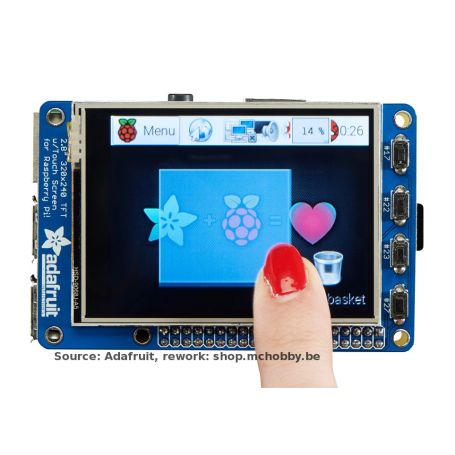TFT display 2.8" for Raspberry-Pi (PiTFT plus, assembled)
2.8" TFT display for Raspberry Pi
- 2.8" diagonal
- 320x240
- Interface GPIO (SPI)
- Touch (via SPI)
Payments are secured by LyraCollect, a French payment collection company.
It is possible to delivered to your home, to a pick-up point or picked up by appointment at MCHobby
We prepare, pack and ship your orders with great respect and care.
A 2.8" color display to plug on the Raspberry-Pi GPIO
Need a nice little display for Raspberry-Pi? This is the PiTFT Plus 2.8".
It consists of a 2.8" display (71mm diagonal) with a resolution of 320x240 in 16-bit color and a resistive film to make a touch screen.
This card uses the Pi's high speed SPI interface and can be used as a mini display console, X Window port, image or video display, etc. The best left for the end, you simply plug it into the GPIO of your Raspberry-Pi!
This version of the PiTFT 2.8" is updated to perfectly match the Pi Zero, Pi 3, Pi2 or A+ and B+ (all Pi with a 2x20 connector). Not suitable for older Pi 1 with 2x13 connector.
This card is also equipped with a 40-pin male connector under the card to connect a GPIO ribbon to connect a Cobbler.
The display and the touch panel use the pins of the SPI interface (SCK, MOSI, MISO, CE0, CE1) as well as the GPIO #24 and #25. As there remain a little room, Adafruit added 4 buttons connected to 4 GPIO (#17,#22,#23,#27), you can use them to achieve a basic user interface. For example, you can use one of the buttons to control the extinction of the Raspberry-Pi.
You can use this screen to display the X Windows graphical interface, although 320x240 is quite small. We recommend using PyGame or other programs based on SDL (which can write directly in the frame buffer).
GPIO pins used
PiTFT uses the hardware SPI interface pins (SCK, MOSI, MISO, CE0, CE1) as well as GPIO pins #24 and #25. All other GPIO pins are available. Pins #17,#22,#23,#27 are connected to the buttons next to the screen. The GPIO pin 18 can be used to control the power of the backlight using a PWM signal.
Additional GPIO breakout The bottom of the card is equipped with an additional connector 2x20 pins (Raspberry-Pi B+) to connect a 40-wire GPIO cable. So, you can also use the other GPIO signals still available.
If you need more GPIO, other inputs/outputs are available under the card breakout (via connection pads that you can weld)
Mounting holes
The card is equipped with 4 mounting holes to fix the PiTFT Plus and the Raspberry under a surface (or frame).
Contain
This product is delivered assembled ready to be plugged into your Raspberry-Pi:
- A female connector 2x20 pin to connect the card to your Pi 3, Pi 2, A+, B+
- A male connector 2x20 pin to connect an IDC cable or a 2x20 Cobbler to the side of the card or a GPIO 40 ribbon to use your Pi-TFT with your own expansion cards
No need to welded, The PiTFT-PLUS is delivered assembled
Tutorial
Adafruit has developed a Kernal package based on the incredible work of Notro on the FrameBuffer. It is therefore possible to easily install this package on existing (and derived) Raspbian images using a few commands.
See the tutorial below for how to install the software part, calibrate the touch screen, display videos, display images (ex: from the PiCam), etc
- Installation tutorial in French (on the MCHobby wiki)
- Adafruit installation tutorial (AdaFruit, English)
Project ideas around PiTFT
- Realize a WiFi touch camera with a Raspberry Pi (Adafruit. English)
Make your own photographic capture camera connected to the Cloud - Touchscreen Pi Timelapse Controller (Adafruit. English)
Create a translation rail for camera, controlled by Raspberry Pi and PiTFT 2.8" touch - SnapPiCam Raspberry Pi camera (Adafruit. English)
Make your own portable camera with a Raspberry Pi - Mini Mac Pi (Adafruit. English)
The smallest and most cute project inspired by a Mac Classic. - PiPhone - A cell phone made from Raspberry Pi (Adafruit. English)
Why should you have the same mobile phone as everyone else when you can do your own? - RasPi - A photo frame displaying animated GIFs (Adafruit. English)
Another way to see your cat waddling on your desk ;-) - Run OpenGL games and emulators & on a PiTFT display (Adafruit. English)
More games = more Fun! - Cupcade: Arcade micro console with Raspberry-Pi (Adafruit. English)
A small tribute to the classic games of the 1980s - PiGRRL - Raspberry Pi Gameboy (Adafruit. English)
The best case for a Raspberry Pi! - Raspberry Pi Radio - with touch screen (Adafruit. English)
Realize a desktop radio capable of receiving radio streams from your favorite stations. - 3D printing AstroPrint (Adafruit. English)
3D wireless printing for Raspberry Pi - RasPipe: a pipelined Raspberry Pi viewer, Part 1 (Adafruit. English)
A very didactic tutorial for the nosy (the hacker) of all kinds... 3 stars. An exploration of standard inputs/outputs, Unix filters, and simple graphical display with Python et Pygame. - apt.adafruit.com (Wiki MCHobby, French)
apt.adafruit.com (Adafruit. English)
The Adafruit Raspberry Pi Package Repository











